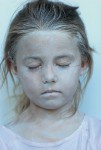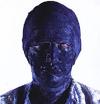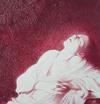» Press and Media
Texts and Essays
Schroedel Schulbuchverlag – 30. November 1987
das Selbstportrait im Grundkurs Kunst
GRUNDKURS KUNST 1
Material für den Sekundarbereich II
Malerei,Grafik,Fotografie
SELBSTPORTRAIT
Albrecht Dürer, Rembrandt, Angelika Kaufmann, Caspar David Friedrich,Vincent van Gogh, Max Beckmann, Salvador Dali, Arnulf Rainer, Gottfried Helnwein.
Fotorealistischer Aufschrei, Gottfried Helnwein's Selbstportrait, 1983
"DER UNTERMENSCH ,Edition Braus, Heidelberg – November 30, 1987
One Man Show at the Museum of Modern Art, Strasbourg, 1988
THE DIVIDED SELF, Gottfried Helnwein in his self-portraits
Je est un autre, RIMBAUD
Helnwein compared the "quietly theatrical" ecstatic attitude of his self-portrait with the heroic pose of the figure of the suffering figure of Sebastian and generalizes both to the stigma of the artist in the 20th century, making him a kind of saviour figure. In addition, its poetic title sets the viewer onto the right track. The visual montage of the modern artist as Man of Sorrows with Friedrich's landscape painting projects the dashed hopes of the romantic rebellion into the present, to the protest thinking of modernity, which has become introverted and masochistic, and its crossing of aesthetic boundaries.
Is romanticism making a comeback? No; actually, it had never left modernity.
But its rebellion is confining and introverting itself in the "body metaphysics" of contemporary artists to its own flesh and blood.
GOTTFRIED HELNWEIN, Ninth November Night, Catalogue – November 30, 1987
INSTALLATION, "NINTH NOVEMBER NIGHT", AT THE MUSEUM LUDWIG
NINTH NOVEMBER NIGHT
It was to our good fortune that Gottfried Helnwein also strove to break away from the museum and gallery sector in order to communicate with a larger public.
This appeared on a grand scale on the site between the cathedral and Museum Ludwig, and at a time of "photokina", with its hundreds of thousands of visitors. The 100 metre picture wall did not fail to hit its mark:
it induced bewilderment as well as aggressiveness.
After a few days numerous pictures had been slashed, one even stolen.
Gottfried Helnwein saw the exhibition as a process which would continue and be reflected in later presentations.
The pictures were not renewed, but patched up, so that this reminder of the persecution of Jewish people would bear the traces of a lack of insight and understanding in the present day.
Helnwein,DER UNTERMENSCH ,Edition Braus, Heidelberg – November 30, 1987
THE SELF-PORTRAITS
The Self-Portraits of Gottfried Helnwein: A WORLD OF HORROR IN PICTURES
From this it may be seen that the Viennese Helnwein is part of a tradition going back to the 18th century, to which Messerschmidt's grimacing sculptures are to belong, on which one of Freud's pupils wrote a long treatise.
One sees, too, the common ground of these works with those of Arnulf Rainer or Nitsch, two other Viennese, who display their own bodies in the frame of reference of injury, pain, and death.
And one sees how this fascination with body language goes back to the expressive gesture in the work of Egon Schiele.
Gottfried Helnwein, Ninth November Night, Catalogue – November 30, 1987
INSTALLATION, "NINTH NOVEMBER NIGHT", AT THE MUSEUM LUDWIG
THOUGHTS

Not even the children were spared; they, too, fell victim to the destruction. It was Gottfried Helnwein's fantastic idea to present the consequences to this "period without mercy" in such an unconventional manner. He made no use of photos of heaped corpses; children's portraits force the observer to stop and consider this idea.
The fury with which the neo-nazis reacted to these portraits is understandable inasmuch as it is the very same fury with which they have for years been fighting against The Diary of Anne Frank; the murder of children rouses abhorrence and conflict in every human, whether they are motivated by ideology or insanity. The urge to destroy has survived; the portraits bear witness to its rage - an attempt was made to cut them to shreds.
"People, please, stop,... look at these children's faces, multiply their number by a few hundred thousand. Only then will you realise or gain an inkling of the extent of this holocaust, of the greatest tragedy in human history!"
Gottfried Helnwein, Ninth November Night, Catalogue – November 30, 1987
INSTALLATION, "NINTH NOVEMBER NIGHT", AT THE MUSEUM LUDWIG
REICHSKRISTALLNACHT - Night and Fog
"In the struggle against the Jew, I defend the acts of God!" Those were Hitler's words in Mein Kampf.
Gottfried Helnwein, Ninth November Night, Katalog – 30. November 1987
INSTALLATION, "NINTH NOVEMBER NIGHT", AT THE MUSEUM LUDWIG, 1988
BLACK MIRROR

Wie hält ein freundlicher Mensch wie Helnwein es aus, seine exzellente - Malerei zum Spiegel der Schrecken des Jahrhunderts zu machen?
Oder hält er es einfach nicht aus, das nicht zu tun?
Reflektiert sein Spiegel nur die Jahrhunderthaltung, LIEBER EIN SCHRECKEN OHNE ENDE ALS EIN ENDE MIT SCHRECKEN, die aus der Überbewertung des Todes kommt, Folge seiner Tabuierung durch Statistik.
Perseus, der die Gorgo im Spiegel guillotiniert, und wenn der Kopf fällt, ist es der eigene.
Wie viel Köpfe hat ein Mensch / Mann in unserem Zeitalter der Spiegel?
Gottfried Helnwein, Ninth November Night, Catalogue – November 30, 1987
INSTALLATION, "NINTH NOVEMBER NIGHT", AT THE MUSEUM LUDWIG
Black Mirror

. . . How does a friendly person like Helnwein stand making his - excellent - painting into a mirror of the terrors of this century? Or is it that he can't stand not doing it?
ZYMA, Feuilleton, Kunstmagazin – 31. Mai 1987
one-man show
GOTTFRIED HELNWEIN, DIE NEUEN BILDER
Hinsehen und wiedererkennen. Dieser Reflex steht am Anfang der Auseinandersetzung mit den Arbeiten Gottfried Helnweins und ist zugleich programmatisches Element einer lesbaren Kunst.
ART of the 20th Century, TASCHEN – November 30, 1986
Painting - Sculpture - New Media - Photography
Painting - Sculpture - New Media - Photography



